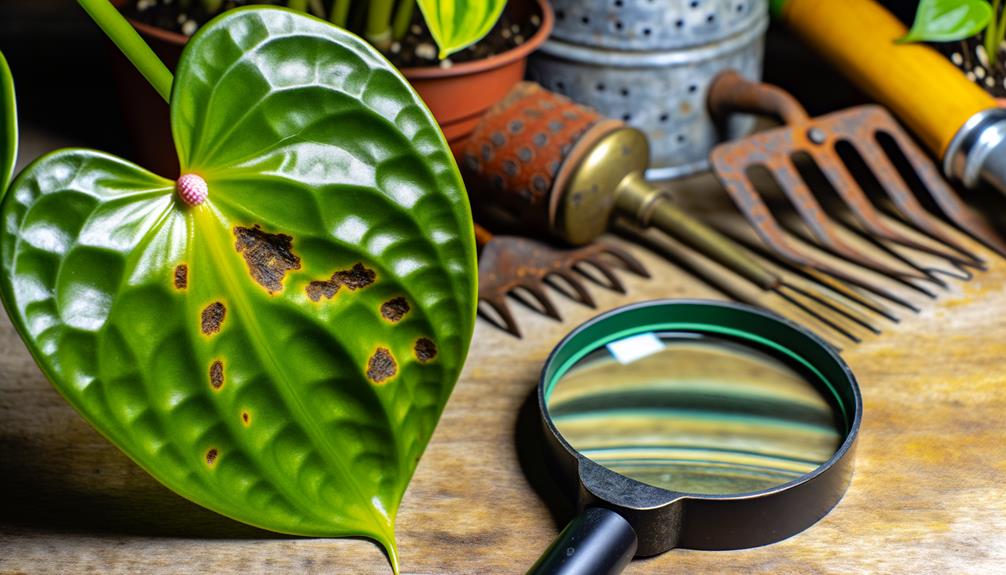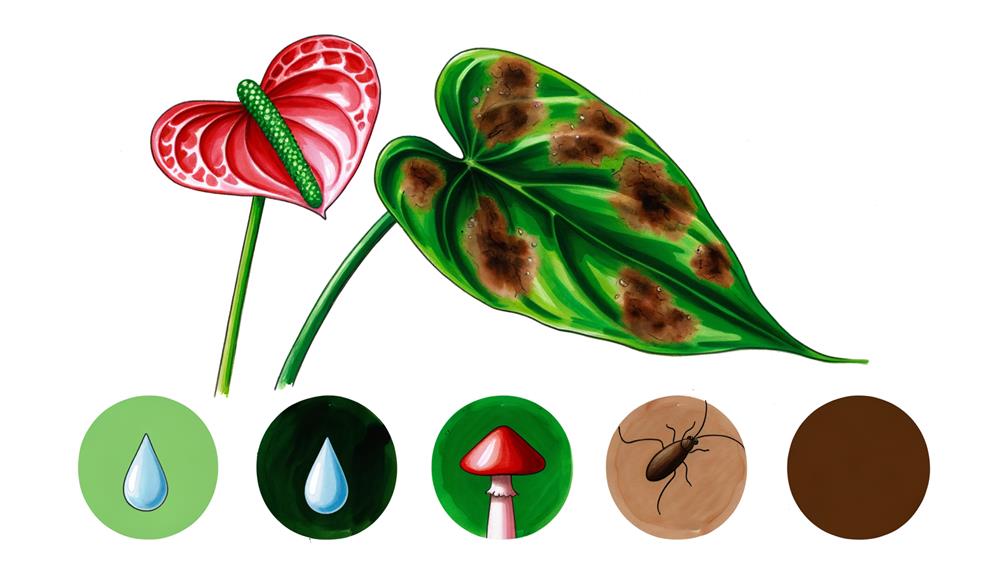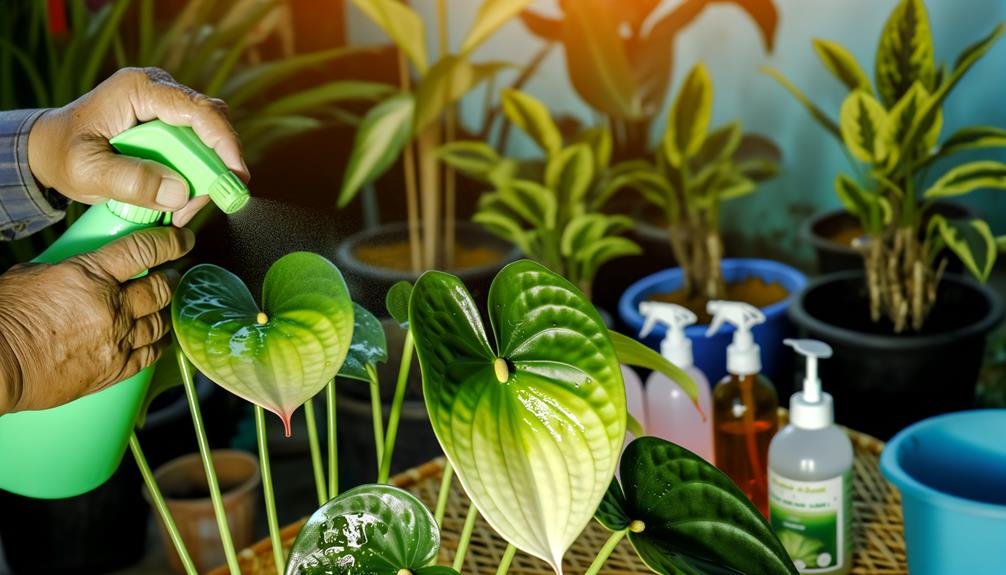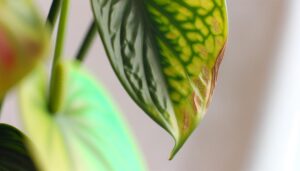Diagnosing and Treating Brown Spots on Anthurium Plant Leaves
Diagnose brown spots on Anthurium leaves by first identifying possible causes: improper watering, fungal infections, nutrient deficiencies, or pest infestations. Fungal infections like Anthracnose or Phytophthora can cause distinctive lesions.
Inspect leaves for spider mites, aphids, or mealybugs. Maintain ideal watering—avoid overwatering to prevent root rot and make sure proper humidity levels are maintained.
Correct nutrient deficiencies with balanced fertilizers while monitoring soil pH. Prune affected leaves and adjust light exposure to prevent over or underlighting.
Effective treatments include antifungal applications and pest control methods. For a thorough understanding on these steps, explore further.

Key Takeaways
- Inspect for fungal infections, such as Anthracnose, that cause brown, sunken spots on leaves.
- Ensure proper watering; overwatering can lead to root rot and brown leaf spots.
- Maintain adequate humidity by misting leaves and using a well-draining potting mix.
- Check for pests like spider mites and aphids, and treat with neem oil or insecticidal soap.
- Optimize sunlight exposure and correct nutrient deficiencies with balanced fertilizers.
Identifying Common Causes

To accurately identify the common causes of brown spots on Anthurium plant leaves, you need to consider factors like improper watering, fungal infections, and nutrient deficiencies.
Nutrient deficiencies often appear as brown, necrotic patches due to a shortage of essential minerals like magnesium and calcium. Environmental stress, including improper lighting, can worsen these deficiencies.
Overfertilization leads to salt buildup in the soil, harming root systems and causing leaf discoloration.
Inadequate or excessive light also stresses the plant, further contributing to leaf spot issues. Evaluating your plant’s environment and nutrient regimen is essential.
Ensure balanced fertilization and appropriate light exposure to alleviate these stressors and maintain healthy Anthurium foliage.
Fungal Infections
Although Anthurium plants are generally resilient, fungal infections like Anthracnose and Phytophthora can quickly cause brown spots on their leaves if environmental conditions are favorable for pathogen growth.
You should focus on soil management and proper ventilation to combat these infections. Ensure the soil drains well and avoid overwatering, which creates a substrate for fungal proliferation.
Improving air circulation around your Anthurium will reduce humidity levels, thus inhibiting fungal growth.
Here’s a quick reference table:
| Fungal Infection | Symptoms | Prevention Tips |
|---|---|---|
| Anthracnose | Brown, sunken spots | Avoid overhead watering |
| Phytophthora | Water-soaked lesions | Use well-draining soil |
| Fusarium Wilt | Yellowing leaves | Sanitize tools and pots |
| Botrytis Blight | Gray mold | Increase air circulation |
| Pythium Root Rot | Root rot | Ensure proper soil drainage |
Proper soil management and ventilation are crucial for healthy Anthurium plants.
Pest Infestations
When dealing with pest infestations on Anthurium plants, it’s essential to identify common culprits such as spider mites, aphids, and mealybugs, which can cause brown spots and other damage to the leaves.
These pests often thrive due to seasonal variations and plant stress. You can use chemical pesticides for rapid control, but be cautious of potential harm to the plant and environment. Alternatively, natural remedies such as neem oil or insecticidal soap offer a safer approach, especially for indoor plants.
Regularly inspect your Anthurium, particularly during warmer months when pests are more active. Early detection and treatment are vital to preventing extensive damage and maintaining plant health.
Watering and Humidity
Maintaining proper watering and humidity levels is essential for preventing brown spots on Anthurium leaves, as these plants thrive in consistently moist, but not waterlogged, environments.
Guarantee adequate drainage by using a well-aerated potting mix and containers with drainage holes.
Overwatering can lead to root rot, which causes brown spots. Misting the leaves regularly helps maintain humidity levels above 60%, which is ideal for Anthuriums.
Avoid placing the plant near heating vents or in drafty areas to ensure temperature control. Optimum temperature ranges from 65-80°F.
Proper leaf care includes wiping leaves with a damp cloth to remove dust, allowing for better photosynthesis and moisture absorption. Consistent monitoring of these factors will promote healthy, spot-free leaves.
Treatment and Prevention

To effectively treat and prevent brown spots on Anthurium leaves, identify and address the underlying causes such as fungal infections, nutrient imbalances, or pest infestations.
Start by optimizing sunlight exposure, ensuring the plant receives indirect light. Correct nutrient deficiency by using balanced fertilizers.
Regularly monitor soil pH, aiming for a slightly acidic range of 5.5-6.5. Employ proper pruning techniques to remove affected leaves, reducing disease spread.
Below is a quick reference table for effective treatments:
| Issue | Treatment | Prevention |
|---|---|---|
| Fungal Infections | Fungicide application | Improve air circulation |
| Nutrient Deficiency | Balanced fertilizer | Regular soil testing |
| Pest Infestations | Insecticidal soap | Routine plant inspection |
Consistent care and monitoring will keep your Anthurium healthy.
Conclusion
You’ve now explored the key reasons behind those pesky brown spots on your Anthurium leaves and how to tackle them effectively.
Did you know that up to 70% of houseplant issues are due to improper watering?
By adjusting your watering habits, monitoring humidity levels, and treating fungal infections and pests promptly, you can guarantee your Anthurium thrives.
Remember, early diagnosis and intervention are essential for maintaining those vibrant, glossy leaves you love.






